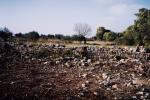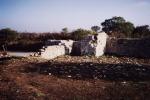Summary (English)
During October 2005, a small excavation was carried out at the site of Dvorine (also known as Kućare). The site is located about a kilometre from the town of Sv. Filip i Jakov, along the road of the Sv. Filip i Jakov – Sikovo (area of about 750 m²). The manor is linked to the rich Benedictine Rogov Abbey, which had its own properties in that area. In the 11th century, Croatian King Petar Krešimir IV was endowing the Abbey with estates. After the ravages of the Turks in the 16th century, Rogovski dvor (Dvorine) and its estates were abandoned, and the people moved to Sv. Filip i Jakov. In the 16th and 17th centuries, Dvorine was repaired by the Turks, who placed a border and customs checkpoint there. The first notes about Dvorine and Rogovšćice are given by Ć. Iveković, which shows a rectangular floor plan measuring 29 × 21 m with a preserved tower measuring 5 × 5 m. First archaeological excavation was limited to clearing the interior of the building and the access road due to the dense maquis and trees that threatened the site. More than 160 m³ of plants, humus and waste were removed, after which the outer walls on the northwest side appeared, as well as a smaller partition wall in the interior. Apart from collapsed walls and tiles, there were no other finds. According to the local inhabitants, finds from the Roman period were also found in the vicinity of Dvorine and in the wider area of Rogovo, which is also mentioned in the literature. Conservation includes the south-eastern wall, which was damaged during the widening of the road. After cleaning the base of the wall, a new foundation was installed at a length of approximately 2.20 m and a height of 45 cm. After that, the base of the wall was restored in a length of 5.50 m and further deterioration was prevented. In the next phase of the works, excavation and conservation are planned (Filip Đinđić 2006, Hrvatski arheološki godišnjak 2/2005, 301).
Director
- Filip Đinđić
Team
Research Body
- Zavičajni muzej u Biogradu na Moru
Funding Body
- Ministarstvo kulture Republike Hrvatske
- Općina Sv. Filip i Jakov






![Download [PDF]](/excavation/skins/fasti/images/results/download_sml.png)
